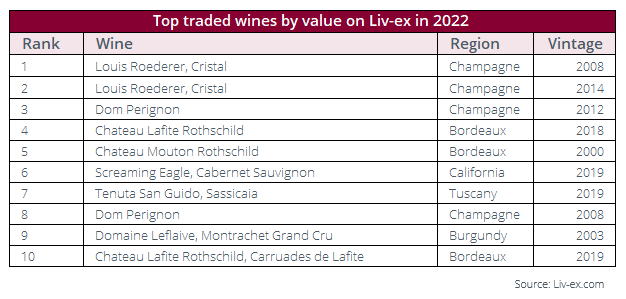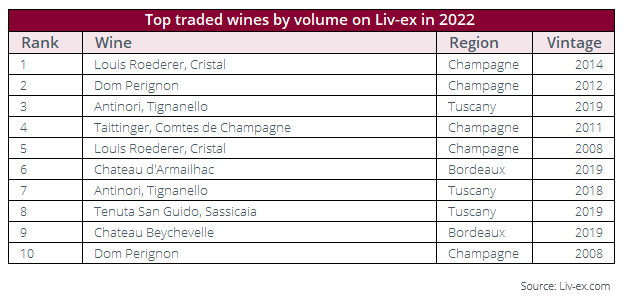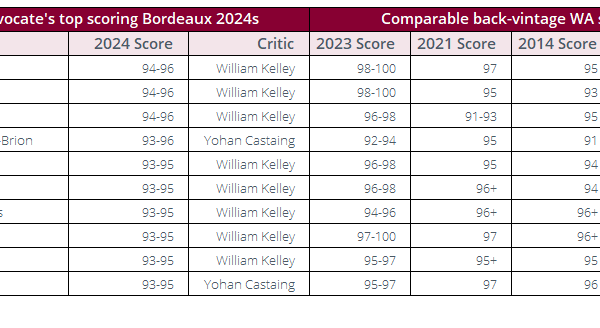- Louis Roederer Cristal 2008 has been the most traded wine by value this year.
- Cristal 2014 has led trade by volume.
- Champagne dominates both rankings, as its market share has seen the most substantial increase among all regions.
A sparkling year for Champagne trade
The rankings of the most traded wines on Liv-ex reveal the market’s relentless focus on Champagne this year. Champagne’s market share by value saw the most substantial increase across all fine wine regions, rising from 8.8% of total trade in 2021 to 13.7% in 2022. The number of Champagnes trading also rose 14.8% year-on-year, to 381 wines (measured as LWIN7s).
Additionally, for five consecutive months (June-October), the Champagne 50 was the best-performing sub-index of the Liv-ex 1000, although it suffered a serious setback in November.
The three top traded wines by value in 2022 all came from the region; Louis Roederer Cristal 2008 and 2014 and Dom Pérignon 2012.
The Champagnes were followed by the Bordeaux First Growths, Château Lafite Rothschild 2018 and Château Mouton Rothschild 2000. Bordeaux trade increasingly focused on blue-chip wines from the top vintages as the year progressed.
One Super Tuscan also made the rankings. Sassicaia 2019, was the seventh most traded wine by value and the eighth by volume this year, in what was a smaller market overall for Italian wine compared to 2020 and 2021.

The most traded wines by volume
When looking at the top 10 traded wines by volume, the three Champagnes mentioned above made the list, along with Taittinger Comtes de Champagne 2011 and Dom Pérignon 2008.
The Super Tuscan Tignanello also featured with its 2019 and 2018 vintages. Of the top five super Tuscans, Tignanello continues to offer the lowest point of entry into the category.
It has also been the best-performing Super Tuscan this year, rising in value by 16.5% on average.
The most traded wines from Bordeaux by volume were the 2019 vintages of the Fifth Growth Château d’Armailhac and the Fourth Growth Château Beychevelle.

The tables above are an extract from Liv-ex’s latest report, The Fine Wine Market in 2022, which examines the impact of political and economic headwinds on the fine wine secondary market, the top performing wines and regions in 2022 and what to expect in 2023.
Other key findings in the report include:
- Fine wine continued to outperform equities and commodities – cementing its worth as an alternative asset and hedge against inflation.
- The number of wines trading has overtaken the 2021 record – although the rise is slowing.
- Despite a successful year, the wider economic storm affected the secondary market – the Liv-ex Fine Wine 100 recorded it first dips in 18 months.
- Bordeaux’s market share fell to yet another low this year – 34.5% of total trade by value.
- The number of Burgundian wines traded on the market rose to over 4,000 – a dramatic increase for a region whose secondary market share used to focus on a tiny handful of wines.
- Despite their strong performance in the early stages of the year, market sentiment for Champagne and Burgundy has begun to decline, with many high value Burgundies becoming increasingly difficult to sell.
- Warning signs in the various Liv-ex indices point to a period of drift for the fine wine market in the short term.
To download your complimentary copy of our annual market report, fill in the form below.



